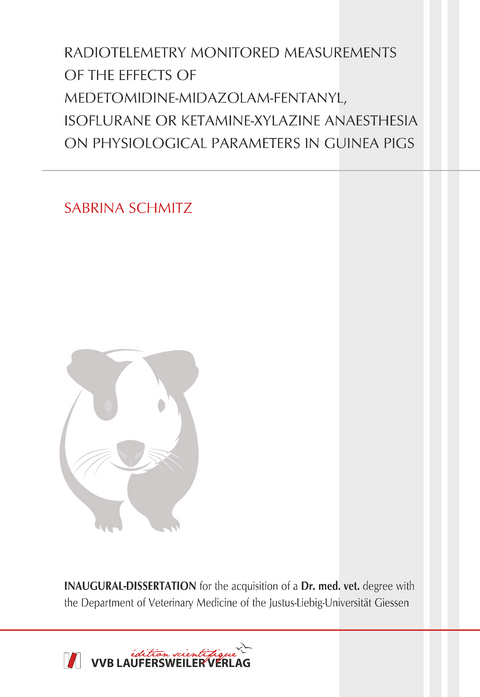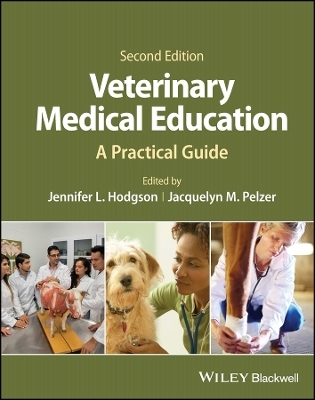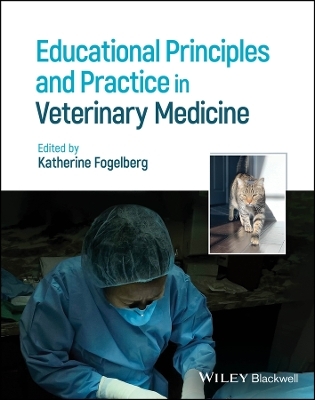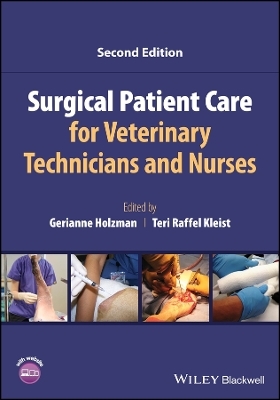
Radiotelemetry monitored measurements of the effects of medetomidine-midazolam-fentanyl, isoflurane or ketamine-xylazine anaesthesia on physiological parameters in guinea pigs
Seiten
2017
VVB Laufersweiler Verlag
978-3-8359-6556-0 (ISBN)
VVB Laufersweiler Verlag
978-3-8359-6556-0 (ISBN)
- Keine Verlagsinformationen verfügbar
- Artikel merken
Anaesthesia in guinea pigs (GPs) has often been described as difficult and risky. Therefore, the included publications invested the effect of the mostly used anaesthesias MMF (medetomidine-midazolam-fentanyl), isoflurane (Iso) and ketamine-xylazine (KX) on physiological parameters in GPs. Throughout the anaesthesia, the GPs’ cardiovascular parameters were monitored, using abdominally implanted radiotelemetry devices to obtain optimal data quality.
The surgical approach used for the implantation of the radiotelemetry transmitter is presented in detail in the first publication. For surgery, the GPs were anaesthetised with MMF (medetomi-dine-midazolam-fentanyl) and they were antagonised with AFN (atipamezole-flumazenil-nalxone) at the end of the surgery. For pain medication, the GPs were started on meloxicam (0.4 mg/kg) and metamizole (80 mg/kg) 30 min before the surgery. Metamizole was continued for 24 h after surgery and meloxicam for 2 more days. During the implantation, they were additionally covered with the fentanyl component in MMF. Prior to the surgery, enrofloxacin (10 mg/kg) was applied for antibiotic coverage which was continued for 2 more days. Using the implanted system, arterial blood pressure (BP), heart rate (HR) and core body temperature (BT) were measured throughout the first 24 h after the end of the implantation. The implantation approach led to the highest long-term survival rate reported to date, with 13 of 16 GPs (81 %) surviving. The GPs lost body weight (BW) until 2 d after surgery (-11.9 %, -53.6 g) but steadily increased their weight thereafter. The GPs had returned to physiological values in BP and BT at 8 h after abdominal surgery and at 24 h regarding HR. As GPs are stress-prone, recommendations for stress reduced handling were given for before, during and after the implantation. The findings on the effects of the implantation can be used as a model for other abdominal operations in the GP.
The second publication described the investigation of the effects of one-time Iso, MMF and KX anaesthesia on the physiological parameters using the 13 implanted GPs. Each animal was anesthetised once with MMF, Iso and KX at an interval of 7 d. The entire anaesthesia pass was recorded radiotelemetrically and supplemented by manual measurements of respiratory rate (ReR), reflexes and blood glucose (BG). One anaesthesia pass included 120 min acclimatization time, of which the last 15 min were averaged as individual baseline values. The GPs were then premedicated; with Iso with atropine and with MMF and KX with sodium chloride as placebo. Ten minutes later, anaesthesia was initiated, for Iso anaesthesia using a pre-filled whole body chamber and for MMF and KX with intramuscular injections into the hind limbs. Anaesthesia was discontinued after 40 min by Iso supply stop, AFN antagonisation for MMF or partial antagonisation with atipamezole for KX anaesthesia. The MAP, HR, BT were measured continuously until at least 240 min after anaesthesia induction. Respiratory rate (ReR) was measured until at least 55 min and reflexes were tested until the GPs showed a positive righting reflex again. BG values were measured at 7.5, 20 and 40 min during anaesthesia.
With Iso use, all GPs reached a surgical tolerance, 11 did so with MMF anaesthesia and only 7 reached an operable state with KX. The induction, non-surgical tolerance and surgical tolerance phase durations did not differ considerably between the 3 anaesthetics. Following MMF and Iso there were short wake-up times (7.6 & 12.2 min), whereas it required 59.7 min until the GPs regained their RR after KX. MMF anaesthesia led to a marked transient MAP decrease after antagonisation, otherwise the MAP and the HR were only mildly altered. Iso exposure led to a marked hypotension during anaesthesia maintenance (approx. 20 mmHg) and the HR was only mildly increased at the beginning of the anaesthesia. KX caused mild deviations from the normal physiology for MAP and HR during maintenance. However, after partial antagonisation, the MAP dropped and the GPs recovered only slowly. The HR was also reduced and increased only gradually during the wake-up following KX anaesthesia.
All anaesthetics induced hypothermia, but the animals lost the most BT with Iso anaesthesia. Immediately after the end of the MMF and Iso anaesthesia, the GPs were able to quickly lift their BT back to the starting level through shivering. After KX anaesthesia only 3 of the 7 GPs had returned to 38.8°C after 5 h, the other 4 still had not reached pre-anaesthetic BT values after 8 h. Respiratory depression occurred with all 3 anaesthetics, with KX leading to a moderate (-52%) and Iso to a severe (-71%) hypoventilation. There was also a strong irritation of the mucous membranes of the respiratory tract through the respiratory gas. Subsequent mucosal secretion could only be alleviated by atropine pre-medication in the short term. BG increases were observed during KX (moderate) and strongly during MMF anaesthesia. The reflex responses varied considerably between the anaesthetics. They were strong and quick during MMF anaesthesia and slightly less so with KX use. Iso exposure led to weak and slow reflex responses. Overall, MMF was determined to be the anaesthesia of choice; Iso can only be advised for short and non-painful procedures and we advise against the use of KX anaesthesia in GPs.
After investigating the effects of single anaesthesia with Iso, MMF and KX, the third paper de-scribed the impact of repeated MMF and Iso anaesthesia. KX was not tested for anaesthesia repetition because of its highly unfavourable effects in the recovery phase. Twelve instrumented MS were anesthetised in 2 anaesthesia sets, 6 times over 3 weeks with either only Iso or only MMF. Each anaesthesia repetition was performed as described for the single anaesthesia.
All GPs reached a surgical tolerance and this could be maintained for the desired 40 min. Overall, the anaesthetic profiles of MMF and Iso did not change greatly with anaesthesia repetition.
During Iso exposure, the repeated atropine premedication caused the HR to increase, and this increase remained longer with progressing repetitions. During MMF the wake-up phase short-ened from the 1st to the 2nd repetition and the MAP and the HR decreased from the first to all following anaesthesias. During the MMF maintenance, there was a large individual variation in the BP between the GPs, but the single animal always exhibited similar MAP values during all of the repetitions. At 40 min of the MMF anaesthesia, the BG had increased particularly strongly in those anaesthesias that were performed with an interval of 2 d.
The BT decrease and the BW increase were not altered. Both anaesthetics can therefore be used repeatedly in the GP with very little change in the anaesthesia profile compared to the single anaesthesias. The GPs developed increasingly stronger defensive reactions which were particularly pronounced with Iso. They reduced the reliability with which the injections of MMF and atropine could be performed and with that the induction of anaesthesia. Although repeated Iso anaesthesia led to lesser repetition-related effects, the highly disadvantageous effects of hypotension, mucous production and hypoventilation with Iso anaesthesia remained and were further worsened by the strong defensive reactions. MMF led to a much more beneficial anaesthesia with the only drawback of altering the BG and the occurring hypothermia. In conclusion, MMF is superior for both single and repeated anaesthesia use in the GP. Iso is only preferable to MMF, if multiple anaesthesias need to be performed on the same day.
The surgical approach used for the implantation of the radiotelemetry transmitter is presented in detail in the first publication. For surgery, the GPs were anaesthetised with MMF (medetomi-dine-midazolam-fentanyl) and they were antagonised with AFN (atipamezole-flumazenil-nalxone) at the end of the surgery. For pain medication, the GPs were started on meloxicam (0.4 mg/kg) and metamizole (80 mg/kg) 30 min before the surgery. Metamizole was continued for 24 h after surgery and meloxicam for 2 more days. During the implantation, they were additionally covered with the fentanyl component in MMF. Prior to the surgery, enrofloxacin (10 mg/kg) was applied for antibiotic coverage which was continued for 2 more days. Using the implanted system, arterial blood pressure (BP), heart rate (HR) and core body temperature (BT) were measured throughout the first 24 h after the end of the implantation. The implantation approach led to the highest long-term survival rate reported to date, with 13 of 16 GPs (81 %) surviving. The GPs lost body weight (BW) until 2 d after surgery (-11.9 %, -53.6 g) but steadily increased their weight thereafter. The GPs had returned to physiological values in BP and BT at 8 h after abdominal surgery and at 24 h regarding HR. As GPs are stress-prone, recommendations for stress reduced handling were given for before, during and after the implantation. The findings on the effects of the implantation can be used as a model for other abdominal operations in the GP.
The second publication described the investigation of the effects of one-time Iso, MMF and KX anaesthesia on the physiological parameters using the 13 implanted GPs. Each animal was anesthetised once with MMF, Iso and KX at an interval of 7 d. The entire anaesthesia pass was recorded radiotelemetrically and supplemented by manual measurements of respiratory rate (ReR), reflexes and blood glucose (BG). One anaesthesia pass included 120 min acclimatization time, of which the last 15 min were averaged as individual baseline values. The GPs were then premedicated; with Iso with atropine and with MMF and KX with sodium chloride as placebo. Ten minutes later, anaesthesia was initiated, for Iso anaesthesia using a pre-filled whole body chamber and for MMF and KX with intramuscular injections into the hind limbs. Anaesthesia was discontinued after 40 min by Iso supply stop, AFN antagonisation for MMF or partial antagonisation with atipamezole for KX anaesthesia. The MAP, HR, BT were measured continuously until at least 240 min after anaesthesia induction. Respiratory rate (ReR) was measured until at least 55 min and reflexes were tested until the GPs showed a positive righting reflex again. BG values were measured at 7.5, 20 and 40 min during anaesthesia.
With Iso use, all GPs reached a surgical tolerance, 11 did so with MMF anaesthesia and only 7 reached an operable state with KX. The induction, non-surgical tolerance and surgical tolerance phase durations did not differ considerably between the 3 anaesthetics. Following MMF and Iso there were short wake-up times (7.6 & 12.2 min), whereas it required 59.7 min until the GPs regained their RR after KX. MMF anaesthesia led to a marked transient MAP decrease after antagonisation, otherwise the MAP and the HR were only mildly altered. Iso exposure led to a marked hypotension during anaesthesia maintenance (approx. 20 mmHg) and the HR was only mildly increased at the beginning of the anaesthesia. KX caused mild deviations from the normal physiology for MAP and HR during maintenance. However, after partial antagonisation, the MAP dropped and the GPs recovered only slowly. The HR was also reduced and increased only gradually during the wake-up following KX anaesthesia.
All anaesthetics induced hypothermia, but the animals lost the most BT with Iso anaesthesia. Immediately after the end of the MMF and Iso anaesthesia, the GPs were able to quickly lift their BT back to the starting level through shivering. After KX anaesthesia only 3 of the 7 GPs had returned to 38.8°C after 5 h, the other 4 still had not reached pre-anaesthetic BT values after 8 h. Respiratory depression occurred with all 3 anaesthetics, with KX leading to a moderate (-52%) and Iso to a severe (-71%) hypoventilation. There was also a strong irritation of the mucous membranes of the respiratory tract through the respiratory gas. Subsequent mucosal secretion could only be alleviated by atropine pre-medication in the short term. BG increases were observed during KX (moderate) and strongly during MMF anaesthesia. The reflex responses varied considerably between the anaesthetics. They were strong and quick during MMF anaesthesia and slightly less so with KX use. Iso exposure led to weak and slow reflex responses. Overall, MMF was determined to be the anaesthesia of choice; Iso can only be advised for short and non-painful procedures and we advise against the use of KX anaesthesia in GPs.
After investigating the effects of single anaesthesia with Iso, MMF and KX, the third paper de-scribed the impact of repeated MMF and Iso anaesthesia. KX was not tested for anaesthesia repetition because of its highly unfavourable effects in the recovery phase. Twelve instrumented MS were anesthetised in 2 anaesthesia sets, 6 times over 3 weeks with either only Iso or only MMF. Each anaesthesia repetition was performed as described for the single anaesthesia.
All GPs reached a surgical tolerance and this could be maintained for the desired 40 min. Overall, the anaesthetic profiles of MMF and Iso did not change greatly with anaesthesia repetition.
During Iso exposure, the repeated atropine premedication caused the HR to increase, and this increase remained longer with progressing repetitions. During MMF the wake-up phase short-ened from the 1st to the 2nd repetition and the MAP and the HR decreased from the first to all following anaesthesias. During the MMF maintenance, there was a large individual variation in the BP between the GPs, but the single animal always exhibited similar MAP values during all of the repetitions. At 40 min of the MMF anaesthesia, the BG had increased particularly strongly in those anaesthesias that were performed with an interval of 2 d.
The BT decrease and the BW increase were not altered. Both anaesthetics can therefore be used repeatedly in the GP with very little change in the anaesthesia profile compared to the single anaesthesias. The GPs developed increasingly stronger defensive reactions which were particularly pronounced with Iso. They reduced the reliability with which the injections of MMF and atropine could be performed and with that the induction of anaesthesia. Although repeated Iso anaesthesia led to lesser repetition-related effects, the highly disadvantageous effects of hypotension, mucous production and hypoventilation with Iso anaesthesia remained and were further worsened by the strong defensive reactions. MMF led to a much more beneficial anaesthesia with the only drawback of altering the BG and the occurring hypothermia. In conclusion, MMF is superior for both single and repeated anaesthesia use in the GP. Iso is only preferable to MMF, if multiple anaesthesias need to be performed on the same day.
| Erscheinungsdatum | 08.08.2017 |
|---|---|
| Reihe/Serie | Edition Scientifique |
| Sprache | englisch |
| Maße | 146 x 210 mm |
| Gewicht | 243 g |
| Einbandart | Paperback |
| Themenwelt | Veterinärmedizin |
| Schlagworte | Doktorarbeit • Uni • Wissenschaft |
| ISBN-10 | 3-8359-6556-5 / 3835965565 |
| ISBN-13 | 978-3-8359-6556-0 / 9783835965560 |
| Zustand | Neuware |
| Informationen gemäß Produktsicherheitsverordnung (GPSR) | |
| Haben Sie eine Frage zum Produkt? |
Mehr entdecken
aus dem Bereich
aus dem Bereich
A Practical Guide
Buch | Hardcover (2024)
Wiley-Blackwell (Verlag)
145,95 €
Buch | Hardcover (2024)
Wiley-Blackwell (Verlag)
124,55 €
Buch | Softcover (2024)
Wiley-Blackwell (Verlag)
95,12 €


